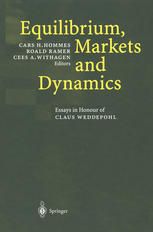

Most ebook files are in PDF format, so you can easily read them using various software such as Foxit Reader or directly on the Google Chrome browser.
Some ebook files are released by publishers in other formats such as .awz, .mobi, .epub, .fb2, etc. You may need to install specific software to read these formats on mobile/PC, such as Calibre.
Please read the tutorial at this link: https://ebookbell.com/faq
We offer FREE conversion to the popular formats you request; however, this may take some time. Therefore, right after payment, please email us, and we will try to provide the service as quickly as possible.
For some exceptional file formats or broken links (if any), please refrain from opening any disputes. Instead, email us first, and we will try to assist within a maximum of 6 hours.
EbookBell Team

4.0
76 reviewsThis book contains essays in honour of Claus Weddepohl who, after 22 years, is retiring as professor of mathematical economics at the Department of Quantitative Economics of the University of Amsterdam. Claus Weddepohl may be viewed as th~ first Dutch mathematical economist in the general equi librium tradition of Arrow, Debreu and Hahn. The essays in this book are centered around the themes Equilibrium, Markets and Dynamics, that have been at the heart of Weddepohl's work on mathematical economics for more than three decades. The essays have been classified according to these three themes. Admittedly such a classification always is somewhat arbitrary, and most essays would in fact fit into two or even all three themes. The essays have been written by international as well as Dutch friends and colleagues including Weddepohl's former Ph. D. students. The book starts with a review of Claus Weddepohl's work by Roald Ramer, who has been working with him in Amsterdam for all those years. The review describes how Weddepohl became fascinated by general equilibrium theory in the early stages of his career, how he has been working on the theory of markets throughout his career, and how he turned to applications of nonlinear dynamics to price adjustment processes in a later stage of his career. The first part of the book, Equilibrium, collects essays with general equilib rium theory as the main theme.